Explore the Rich Heritage of Indian Folk Art
|
Table of Contents
2. Popular Forms of Indian Folk Art 4. Cultural Importance of the Folk Art of India
|
Indian folk art brings to life the essence of village traditions—imagine walking into a rural home where mud walls are adorned with intricate patterns narrating tales of gods, nature, and daily life. The Deep within Bihar, an artist gently dips a twig in natural pigments and begins painting a masterpiece in Madhubani style. Across the sweeping expanse of Maharashtra, a tribal woman draws white Warli figures with rice paste, evoking the culture of her people. In Odisha, an expert hand sweeps a brush across a scroll, bringing to life a colourful Pattachitra scene telling a Ramayana tale. These are moments woven into the fabric of artisans' daily lives, the soul of Indian folk art.
While India is a country of various cultures, traditions, and artistic expressions, one of the most exciting features of this nation is its heritage of folk art. So let’s dive deeper into this rich legacy of Indian through the present blog.
What is the significance of Indian folk art?
India's artistic heritage spans thousands of years, reflecting its rich history, diverse cultures, and deep spiritual traditions. From the ancient rock paintings of Bhimbetka to the intricate temple carvings of Khajuraho, art has been an integral part of Indian civilization, leaving behind its artistic imprints on cave walls.
While the Mughal era introduced refined miniature paintings, the colonial influences brought new artistic expressions, folk art forms like Madhubani, Warli, and Gond continue to thrive, preserving traditions of indigenous communities across the country.
Over centuries, Indian traditional paintings and folk art have evolved, shaped by local customs, mythology, and the environment. Unlike the grandeur of classical art adorning royal courts, folk art was the preserve of common people in India—rural artisans, tribal communities, and homemakers, each infusing their unique style into their craft.
Today, Indian art blends tradition with modernity, with contemporary artists gaining global recognition. Whether in vivid paintings, elaborate sculptures, or textiles, the enduring legacy of India’s folk art showcases its artistic brilliance, cultural depth, and evolving creativity.
Indian Folk Art Types That Tell Timeless Stories
Folk art holds a vital place in India’s ancient art heritage, vividly narrating the legacy of indigenous communities across the country’s diverse landscapes.
Each art form showcases its uniqueness through distinctive styles, designs, imagery, and the choice of colours or materials used. Deeply rooted in themes of nature, spirituality, religion, and mythology, these art forms reflect the profound connection between humans and their surroundings.
Some of the most popular folk art forms celebrated in India include:
Madhubani Art
Madhubani art, which began in the Mithila region of Bihar, India, is characterized by its intricate patterns, vibrant colours, and dense cultural symbolism.
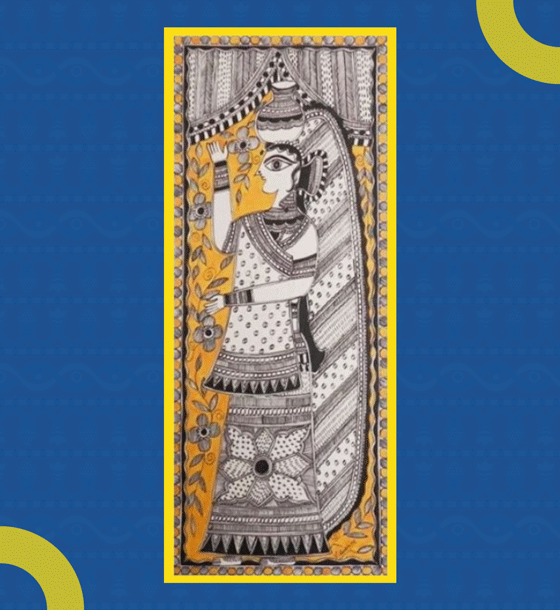 A Madhubani painting by artist Vidushni Prasad depicts a woman in traditional attire carrying a pot on her head.
A Madhubani painting by artist Vidushni Prasad depicts a woman in traditional attire carrying a pot on her head.
Traditionally done by women on mud walls, the painting depicts mythology, nature, and daily life using natural pigments and dyes and drawn with fingers or twigs as brushes.
With its bold lines and complex motifs, Madhubani art has gained popularity globally, maintaining India's rich cultural heritage while evolving into modern forms.
Warli Art
Originating as a traditional art form by the tribesmen of Maharashtra, Warli has its simple depiction of daily activities, nature, and folklore patterns on white against mud walls, gaining international recognition and praise for their style of unique storytelling style.
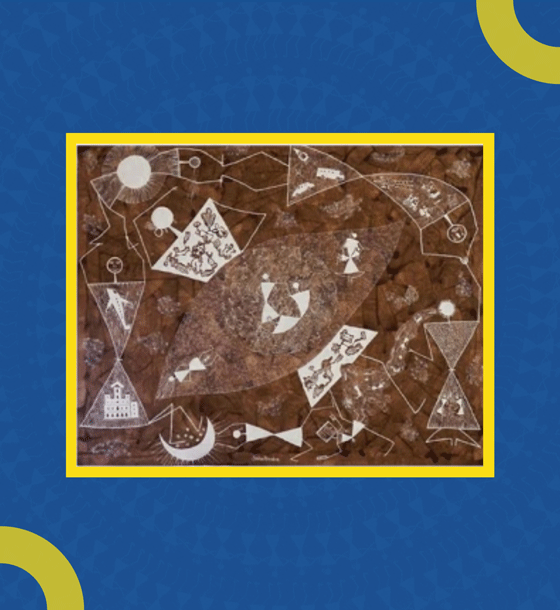 A Warli painting by artist Anil Chaitya Vangad depicts the human bond and progress through their connection with nature.
A Warli painting by artist Anil Chaitya Vangad depicts the human bond and progress through their connection with nature.
Gond Art
Gond Art, a vibrant folk art form from the Gond tribal community of central India, is known for its intricate patterns, bright colours, and storytelling quality. The art often depicts themes of nature, mythology, and daily life, turning simple dots and lines into captivating visuals.
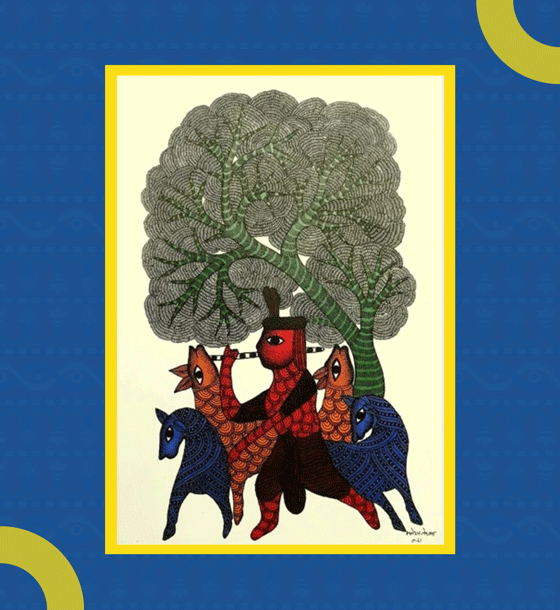 Gond painting Tree of Life by Artist Manoj Tekam, depicts a recurring Gond art theme with a herder, deer, and tree. The tree replicates day and night with green and grey, showcasing the artist's intriguing choices.
Gond painting Tree of Life by Artist Manoj Tekam, depicts a recurring Gond art theme with a herder, deer, and tree. The tree replicates day and night with green and grey, showcasing the artist's intriguing choices.
Created on walls traditionally, it has now made its presence felt on paper and canvas, maintaining the rich cultural heritage of the Gond community.
Kalighat Art
Kalighat painting, originating near the Kalighat Kali Temple in Kolkata in the late 19th century, began as souvenirs for devotees and visitors. Initially focused on religious themes, these paintings eventually expanded to include secular subjects and social commentary.
Created as scrolls or pages, they were used by artist-performers to narrate stories to their audiences. Over time, these works evolved to depict daily life, earning a place in modern art for their unique charm.
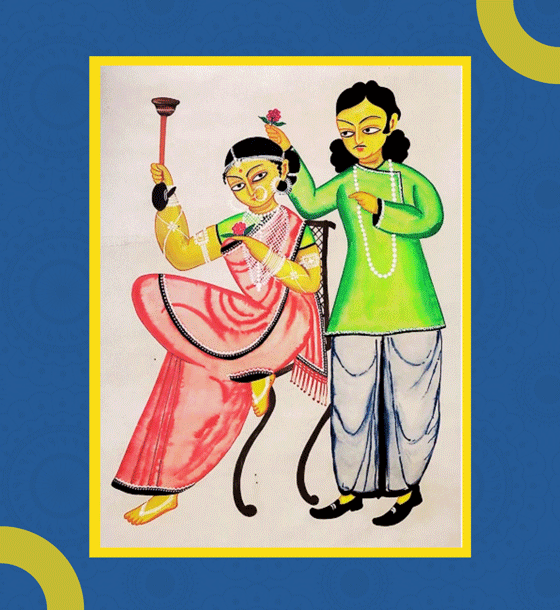 A vibrant Kalam Patua painting in Kalighat Art depicts a romantic scene of a woman with a flower and tobacco burner, while a man places a flower in her hair bun.
A vibrant Kalam Patua painting in Kalighat Art depicts a romantic scene of a woman with a flower and tobacco burner, while a man places a flower in her hair bun.
Pattachitra Art
A traditional painting style performed on a scroll, meaning ‘patta’, often made out of cloth or dried leaves; Pattachitra art originates from Odisha and West Bengal, and is known for its intricate details, mythological themes, and vibrant natural colours. Most of its art portrays tales from the Hindu epics, Ramayana and Mahabharata.
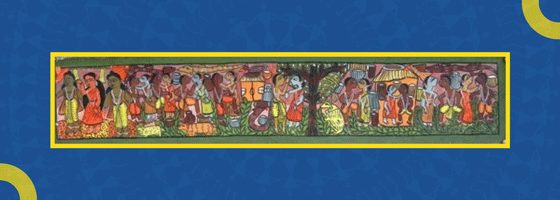 Pattachitra painting depicting a lively village scene with traditional figures and motifs.
Pattachitra painting depicting a lively village scene with traditional figures and motifs.
Phad Art
Originating in Rajasthan around 700 years ago, Phad paintings are made on large scrolls, narrating stories of local deities like Pabuji or Devnarayan, as well as historical legends.
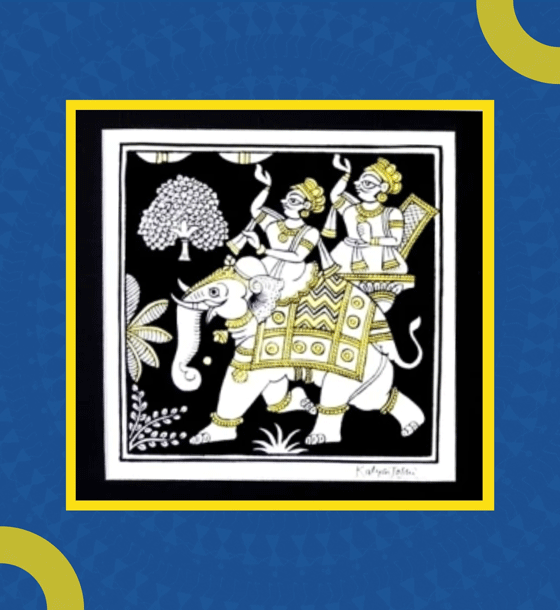 A Phad folk art painting portrays a Mahavat and a royal figure riding a beautifully decorated elephant, set against a striking black, white, and yellow background.
A Phad folk art painting portrays a Mahavat and a royal figure riding a beautifully decorated elephant, set against a striking black, white, and yellow background.
Known for their vivid colours, fine details, and engaging narratives, these paintings hold important significance in Rajasthan's religious traditions and are considered to be "portable temples" to the folk deities.
Kalamkari Art
Kalamkari is an ancient Indian textile painting art that uses precise hand-painting and block-printing techniques. It is native to Andhra Pradesh and Telangana and is named after the term "kalam," meaning pen, and "kari," meaning craftsmanship.
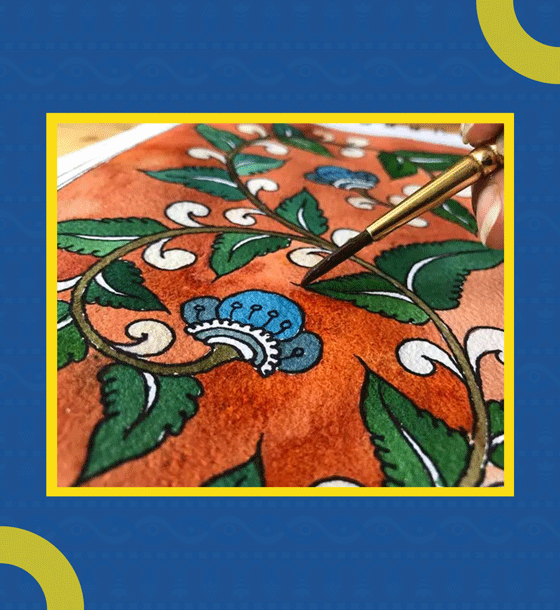 Image credit: Google Images
Image credit: Google Images
The artists use a pen to draw on a piece of cloth which predominantly consists of mythological depictions, nature & floral motifs, and ornate details, all filled with natural dyes.
Lipai Art
Various tribal and rural communities in the Kutch region of Gujarat practice mud-washing in unique styles, using graphic geometric patterns and depictions of humans and animals in Lipai art.
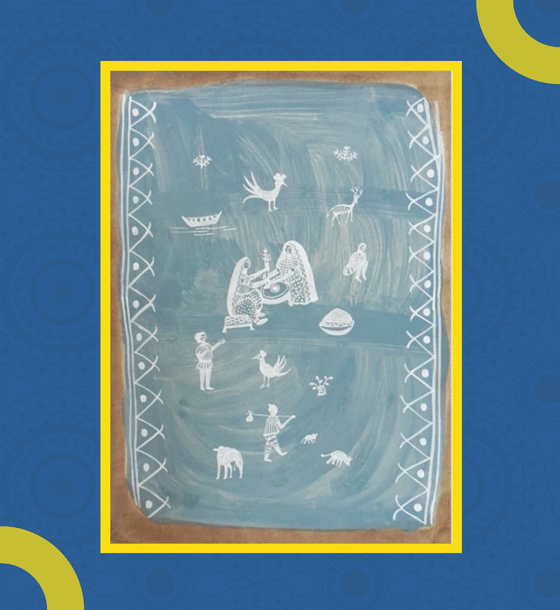 A Lipai art painting by artist Monu Sharma
A Lipai art painting by artist Monu Sharma
Abundant natural clay fostered a rich tradition of clay work, focusing on terracotta and seasonal wall plastering with clay and dung. Over time, this practical technique evolved into an art form, enabling self-expression and gaining global recognition.
Themes in Indian Folk Art
Indian folk art is highly influenced by mythology, nature, everyday life, and symbolism, and represents the cultural and spiritual life of various communities. The art forms are not mere ornaments but represent visual stories that reflect traditions, beliefs, and values.
Some of the commonly used themes of these arts are:
Mythology and Religion
One of the strongest themes in Indian folk art is religion and mythology, with most paintings portraying Hindu epic stories like the Ramayana and Mahabharata. These paintings serve as visual scriptures, conveying religious stories and moral teachings from generation to generation.
For example, Pattachitra paintings bring alive the stories of Lord Jagannath, Krishna, and other gods with vivid detailing and rich colours.
Nature and Animals
Nature and animals are integral to Indian folk art, representing the strong bond between rural society and nature. Much traditional painting honours the coexistence of human beings with nature, supporting ideas of cohabitation and conservation. Nature in the form of flora and fauna is extremely symbolic—tigers of power, elephants of wisdom, and birds of freedom and spiritual affinity between heaven and earth.
Daily Life and Social Customs
Folk paintings are a graphic document of people's everyday existence, reflecting customs, professions, and traditions in various communities. Paintings can also contain symbolic motifs—as, for instance, fish represent fertility and success, and birds express the continuity of earthly and divine worlds. Every motif carries some cultural charge, so those works of art become both the artworks and historical records of life in the village.
Symbolism and Abstract Concepts
Symbolism forms a key aspect of Indian folk art, as most styles utilize abstract motifs to convey more profound meanings. Circles symbolize the sun and moon, triangles represent mountains and trees, and lines indicate human movement and actions in Warli art, for example. All these geometric motifs come together to create elaborate narratives that describe the spiritual and cultural beliefs of the Warli tribe.
Cultural Importance of the Folk Art of India
Indian folk art is more than visual aesthetics; it is narration, spiritual expression, and documentation of socio-cultural activities.
Traditionally, these art forms have been passed down from generation to generation within the family and community context. Most Indian traditional paintings depict rituals, customs and beliefs, festivals, and religious ceremonies, providing the core of community life and its socio-cultural importance.
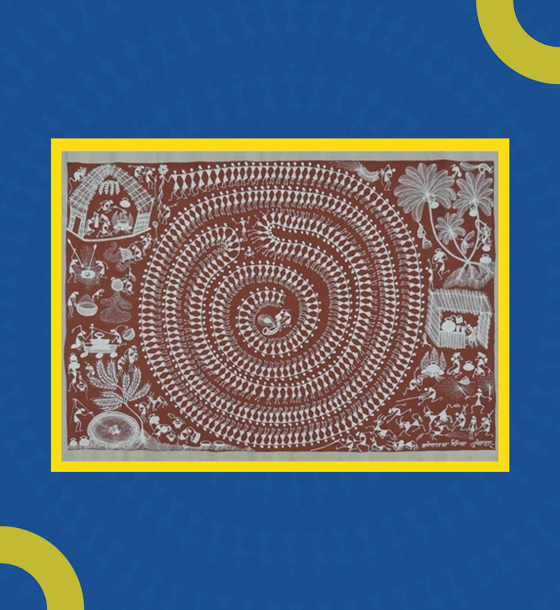 A Warli painting depicts a vibrant Tarpa dance in a circular formation, symbolizing the cycle of life.
A Warli painting depicts a vibrant Tarpa dance in a circular formation, symbolizing the cycle of life.
Folk art, which frequently has its roots in communal, religious, and agricultural customs in India, is intricately woven into people's everyday lives. For instance, Madhubani and Warli paintings are not only visual representations but also carry symbolic meanings, often linked to nature and folklore.
Likewise, traditional crafts such as block printing, pottery, and embroidery are not merely livelihood activities but an integral part of cultural identity, keeping regional traditions and techniques alive. These art forms also act as a source of social bonding, unifying communities during festival rituals.
Indian Folk Art in the International Market
Folk art experienced a massive breakthrough in international markets in the last decade. These traditional art forms are no longer confined to their places of origin. International art fairs and digital platforms have empowered artisans to present their work to a much wider audience worldwide.
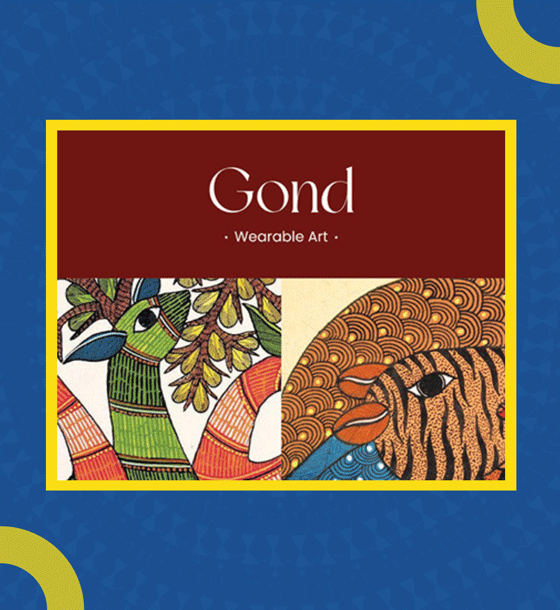 A clothing brand with Gond Art as their logo
A clothing brand with Gond Art as their logo
Designers have proudly integrated traditional patterns and cultural motifs into high fashion, as well as to embellish modern home décor.
A study published in 2014 examines how Indian folk art forms impact contemporary fashion and consumer acceptance https://www.fibre2fashion.com/industry-article/7446/a-study-on-selected-folk-art-forms-with-respect-to-indian-fashion
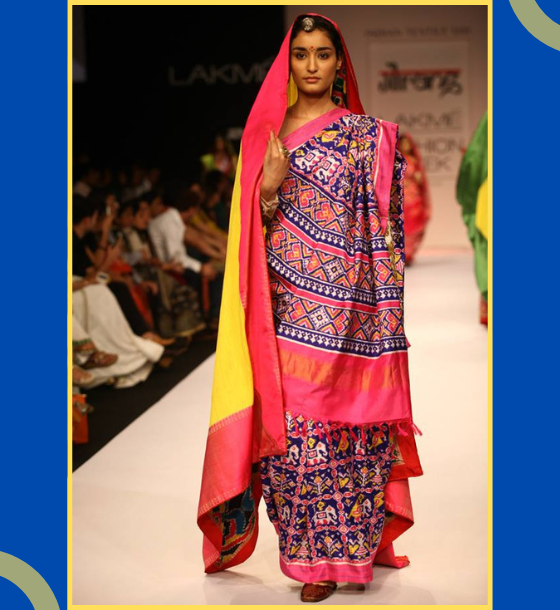 A runway model wearing a saree with a pattern made from Madhubani art
A runway model wearing a saree with a pattern made from Madhubani art
The emergence of e-commerce platforms such as Unique Creations and Arts has further enabled artisans to sell directly to buyers worldwide, thus ensuring fair trade and the authenticity of these art forms.
Governments, along with non-profits, are also working in tandem to popularize Indian folk art through cultural exchange programs, artist residencies, and sustainable craft initiatives, further strengthening its position in the world art arena.
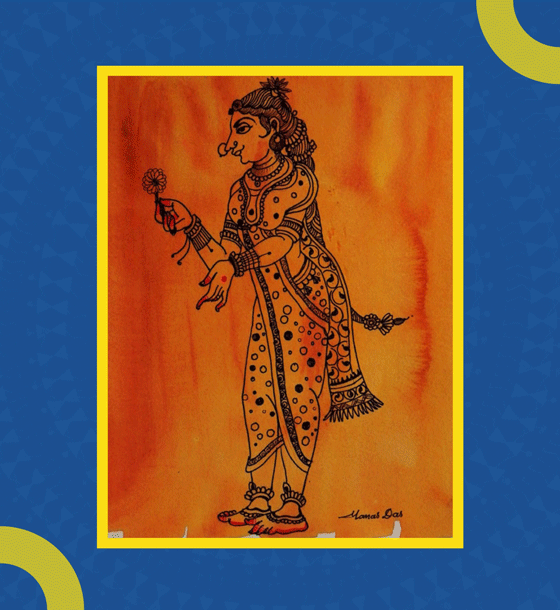 Pattachitra painting as a wall decor.
Pattachitra painting as a wall decor.
Preserving and Promoting Indian Folk Art
Beyond the commercial appeal, Indian folk art remains a vital thread in the cultural fabric of the nation. Every stroke of paint, every carved wooden figurine, every embroidered motif carries forward the untold stories of India's artistic soul.
But despite their cultural importance, many ancient Indian art forms are on the verge of extinction due to modernization and a decline in artisan communities.
A survey study conducted in 2018 by design students sheds light on the effects of the commercialization of these unique art forms https://www.jetir.org/papers/JETIR1811401.pdf.
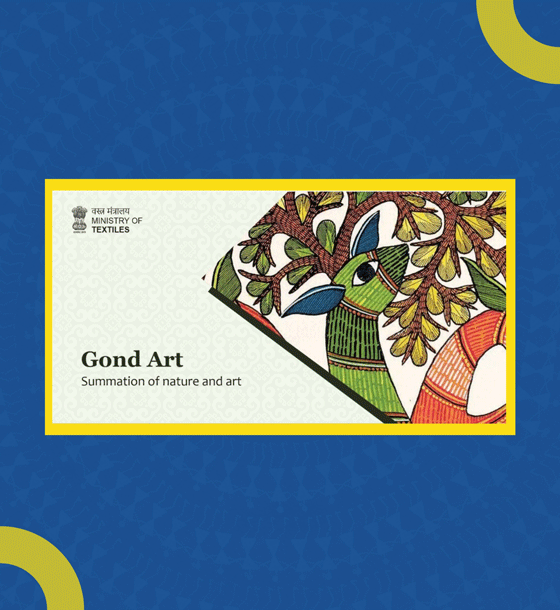 Ministry of Textiles, India, uses the Gond art design in its official logo.
Ministry of Textiles, India, uses the Gond art design in its official logo.
However, the government, private enterprises, NGOs, and art lovers have initiated various activities to revive these art forms through art exhibitions, digital platforms, and fair-trade markets.
While art schools have been started educating students to ensure these art forms reach and be cherished among the younger generations, art galleries and museums work diligently to preserve them.
Furthermore, art lovers and enthusiasts can support folk art by purchasing authentic.
Handmade artworks, attended art fairs, and spread awareness about these traditional practices. Most online platforms provide direct access to artisans, thus helping them sustain their craft in contemporary markets.
Indian folk art is not merely about aesthetics; it is an enriched and dynamic representation of the country's multi-socio-cultural landscape by being democratic, as it cuts across geographical boundaries. It showcases to the world the magnificence of our cultures and traditions, seamlessly woven into the fabric of India's incredible diversity.
Each form of folk art carries with it the tales of the rich art heritage of ancient India through visual storytelling. Hence, it is Indian folk art forms must be preserved to inspire our future generations, as India can only be explored in a true sense by taking a journey down its folk art.
Curious How Indian Folk Art is Transforming Home Décor? Read the Full Blog


Related Blog